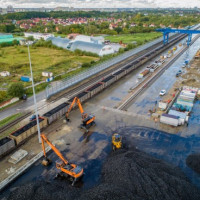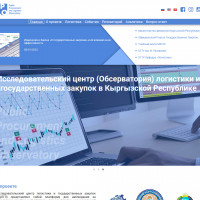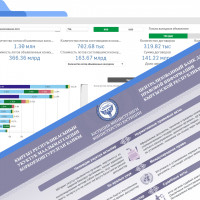Application of analytical data from the website of the Public Procurement and Logistics Observatory for analysis Public Investment Projects (PIP)
Annotation: I examined the use of the database of the "Analytics" module of the BI site pplo.kg at the design stage of public investment projects of the Kyrgyz Republic by procurement specialists. BI (Business Intelligence) is a business intelligence, an application to the site analytics section. This application is integrated with the API and processes data from the public procurement website online. I offered my recommendations on how and to what extent the use of the data in the "Analytics" section can affect the successful outcome of the projects.
Keywords: public investment projects, public procurement, procurement of goods, works and services, disbursement of state funds investment, project implementation.
Sharipova Elmira, master of the International School of Logistics of KSTU named after I. Razzakov.
The Kyrgyz Republic has been dependent on foreign assistance for many years and calls on donors (EBRD, ADB, WB, etc.) to implement national development strategies, to support the budget, to carry out reforms, and to implement infrastructure projects. This assistance is intended for the people of the Kyrgyz Republic, but it is used through state institutions and its use is subject to laws and regulations. Today, all assistance provided to the Kyrgyz Republic is carried out through state institutions. The procedure for initiating, selecting and preparing projects is spelled out in the regulation on public investment management. At the project preparation (design) stage, the Implementing Agencies involve independent experts, representatives of public or private organizations, and may also apply to donors for grant technical assistance for the preparation of project documentation or a feasibility study.
Further, we will talk about projects financed by the World Bank (WB). One of the key areas influencing the successful implementation of the project is the proper development of a procurement plan, in accordance with the planned activities of the Project and writing a procurement strategy. The Bank requires the Borrower to develop a Project Procurement for Development Strategy (PPSP) for each project financed under Investment Project Finance (IPF). The PPSP considers how procurement activities will support project development objectives and deliver Value for Money (VPM) using a risk-based approach. It shall provide adequate justification for the choice of selection methods contained in the Procurement Plan. The level of detail and analysis in the PPSP should be proportionate to the risk, cost and complexity of project procurement. The Initial Procurement Plan usually covers at least the first eighteen (18) months of the Project. All procurement under the Project is carried out in accordance with the procurement guidelines of a particular donor organization (Procurement Guidelines of the WB, ADB, EBRD, SFD, etc.). All project tenders, within the framework of projects, the implementation of which began after July 2016, must be registered and carried out on the state e-procurement portal. The government has adopted a new e-procurement procedure that includes a section related to market assessment and the establishment of a tender commission. In this edition, in chapter 2, paragraphs 13 and 14, states the following:
In developing a procurement plan, the procurement department monitors the market for purchased goods and services. In the course of monitoring, the procurement department, in addition to prices, conducts a study on the availability of the declared subject of the purchase of goods, services on the market and the ability of suppliers to supply the goods / provide services, as well as other essential conditions of the future contract, such as production time, delivery time, in the absence of goods, availability spare parts and service center on the territory of the Kyrgyz Republic.
When purchasing goods and services, the procurement department monitors prices by studying publicly available sources, and analyzes the prices of previous purchases on the web portal by other procuring organizations, and also has the right to analyze prices in public Internet sources or send requests to suppliers to provide commercial offers.
A well-designed procurement plan and a well-designed procurement strategy contribute to the successful implementation of the Project, the achievement of its goals and a high percentage of disbursement of funds. Here one cannot do without a deep analysis of many aspects, which is mentioned in the paragraphs above, and this work can be carried out on the basis of using the database of the "Analytics" module of the BI site pplo.kg, since BI (Business Intelligence) is a business intelligence, an application to site analytics. This application is integrated with the API and processes data from the public procurement website online.
There are three modules in this section:
Evaluation of the effectiveness of the public procurement system
Research on public procurement practices
Search for new opportunities for private corporate business in public procurement.
Let's take a closer look at the first module.
1. Evaluation of the effectiveness of the public procurement system
The Public Procurement Business Intelligence Module is a free multifunctional tool that quickly and accurately helps you navigate the world of public procurement and gain insights into the performance of the public procurement function. The analytics module includes data on all public procurements that were carried out through the public procurement system of Kyrgyzstan.
There are many approaches to analyzing the effectiveness of public procurement. For the macro level, we are offered to evaluate the quality of the procurement process, to make sure that market relations work and there is no monopolization of the market.
Here for analysis, you can find charts for your analysis, such as:
There are many approaches to analyzing the effectiveness of public procurement. For the macro level, we are offered to evaluate the quality of the procurement process, to make sure that market relations work and there is no monopolization of the market.
Here for analysis, you can find charts for your analysis, such as:
The diagrams “Ratings. This a diagrams gives us detailed information about tenders, namely: what purchases are mainly tendered, about participants and suppliers, in which region of the country tenders are held the most and what procurement methods are used. This diagram can be analyzed in other sections, for this it is necessary to use filters. After analyzing all this information, Procurement specialists can start from the data received and, based on this, choose the most appropriate procurement method, the optimal time for holding a tender.
The "Lot Status" chart shows the percentage of the status of lots in real time. For example, as of February 21, 2023, 30.5% of lots were canceled, 53.9% of lots were completed, 9.4% of lots were not held, 4.4% are in process for 60+ days, and 1.8% are in process. As you can see, there is a very high percentage of canceled lots here, and having already this data, the Procurement Specialist needs to study in more detail the reason for the canceled lots in order to avoid mistakes in upcoming tenders.
The diagram "Dynamics" reflects changes in the number of lots of announced tenders and their statuses on a monthly basis. This chart helps to see the time period when the problems started in the procurement of a particular sector, region or a particular customer.
The "Market Concentration" chart gives a good overview of the market structure in terms of product groups and suppliers within each individual product group. It allows you to make sure that there are a sufficient number of suppliers of a particular product group or service on the market, whether there is competition among suppliers, which in turn will affect price and quality, or show whether the market is monopolized or not. In case of market monopolization or lack of competition among suppliers in the market, the Procurement specialist needs to take appropriate measures in advance. This is especially true for tenders for the construction or purchase of some specific equipment.
All these modules work online and the information is relevant for study, in-depth analysis and application. All these tools and diagrams give us the opportunity to deeply analyze ongoing tenders in the country and review the overall picture and the situation in the market of suppliers and goods, and already having all this data, we can begin to develop a procurement strategy for the Project.
Unfortunately, not every Procurement specialist is familiar with this site, as a result of which he is deprived of an additional informative and analytical tool for analyzing data on tenders and procurement in the country. To do this, more work needs to be done to publicize the existence of this platform, as well as to s in the Terms of Reference for Procurement Specialists, the section “Responsibilities of the Consultant” the following paragraph: “The Procurement Specialist needs to review and study the website www.pplo.kg, in addition to other information platforms and portals, conduct an analysis, and apply the results obtained in the development and writing of the PPSD and the procurement plan.
Literature:
https://www.pplo.kg
http://zakupki.gov.kg/popp/
http://cbd.minjust.gov.kg/act/view/ru-ru/14565
https://thedocs.worldbank.org/en/doc/289581506018876505-0290022017/original/ProcurementRegulationsRussian.pdf










